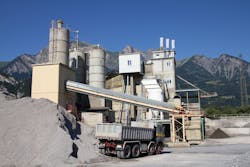Coal Ash Recycling Rate Declines Amid Shifting Production and Use Patterns
58 percent of the coal ash produced during 2018 was recycled — down from 64 percent in 2017, but marking the fourth consecutive year that more than half of the coal ash produced in the U.S. was beneficially used rather than disposed.
"As coal ash production declines, beneficial use markets are adopting new logistics and technology strategies to ensure these valuable resources remain available for safe and productive use," said Thomas H. Adams, executive director of the American Coal Ash Association (ACAA) — an organization that advances the environmentally responsible and technically sound use of coal ash as an alternative to disposal. "Closures of coal-fueled power plants are disrupting product distribution channels, but ash marketers are adapting quickly, and enormous volumes of material remain available for beneficial use."
According to ACAA's "Production and Use Survey," 59.4 out of 102.3 million tons of coal combustion products were beneficially used in 2018. The rate of ash utilization decreased from 64.4 percent to 58.1 percent and the total volume of material used decreased by 12.3 million tons. Coal ash production volume decreased 8 percent (or 9.1 million tons) from 2017 levels.
Coal ash usage
Coal ash is a generic term that encompasses several coal combustion products (CCP) that can be beneficially used in a wide variety of applications. Highlights of CCP production and use in 2018 include:
- Use of coal fly ash in concrete declined 11 percent to 12.5 million tons. Concrete producers and consumers indicated a desire to use more fly ash, but several regional markets were affected by shifting supply dynamics associated with closures of coal-fueled power plants. Fly ash improves concrete durability and significantly reduces greenhouse gas emissions associated with concrete production.
- Use of all coal combustion products in cement production declined 26 percent to 6.4 million tons.
- Utilization of a key non-ash coal combustion product returned to expected levels. Synthetic gypsum is a by-product of flue gas desulphurization units, also known as scrubbers, located at coal-fueled power plants. Use of synthetic gypsum in panel products (i.e. wallboard) declined 23 percent to 12.3 million tons. This volume is consistent with utilization volumes in the 2014–2016 period following a 2017 in which users took advantage of an opportunity to increase stockpiles of gypsum for raw material.
- Synthetic gypsum use in agricultural applications — in which the gypsum improves soil conditions and prevents harmful runoff of fertilizers — declined 16 percent to 1 million tons. Lower utilization is likely related to wet weather that prevented some farmers from applying material to fields.
- Use of CCP in pond closure activities declined 28 percent to 3.2 million tons, but remained well above 2016's total of only 435,000 tons. This activity is driven by utility compliance with coal ash regulations that effectively require an end to the practice of wet disposal. Fly ash, bottom ash, and synthetic gypsum were all used in construction of new permanent disposal facilities.
- Use of fly ash and bottom ash in structural fills rebounded strongly to 4.6 million tons following a multi-year decline.
- Production of boiler slag declined 40 percent as the number of cyclone boilers producing this material also declined. Approximately 468,000 tons of boiler slag was used in the production of blasting grit and roofing granules.
- Approximately 1.2 million pounds of cenospheres were sold in 2018, up from 148,000 in the prior year. Increased cenosphere recovery was likely linked to increased pond closure activities.
"As America's electricity grid changes, the coal ash beneficial use industry is evolving as well," said Adams. "As we work diligently to utilize the 40 percent of coal combustion products that are still disposed annually, our industry is also taking significant strides in developing strategies for improving the quality and availability of these materials."
Adams explained that increasing beneficial use requires ash marketers to ensure that products are consistent and available when customers need them — requiring large investments in technology and logistics. Additionally, the coal ash beneficial use industry is actively deploying technologies and strategies for harvesting coal ash materials that were previously disposed.
About Coal Ash Recycling
Coal is the fuel source for approximately one-third of electricity generation in America and produces large volumes of solid coal combustion products — primarily ash and synthetic gypsum from emissions control devices.
There are many reasons to view coal combustion products as a resource rather than a waste. Recycling them conserves natural resources and saves energy. In many cases, products made with CCPs perform better than products made without it. For instance, coal fly ash makes concrete stronger and more durable. It also reduces the need to manufacture cement, resulting in significant reductions in greenhouse gas emissions — about 11 million tons in 2018 alone.
Major uses of coal combustion products include concrete, gypsum wallboard, blasting grit, roofing granules, and a variety of geotechnical and agricultural applications.
Production and Use Survey
The ACAA conducted a survey quantifying the production and use of coal combustion products in the United States each year since 1966. Data is compiled by directly surveying electric utilities and using additional data produced by the U.S. Energy Information Administration. The survey's results have been used by federal agencies including the U.S. Environmental Protection Agency and U.S. Geological Survey.
Charts summarizing historical production and use data and a tabular version of the 2018 survey results are available on the ACAA website here.
